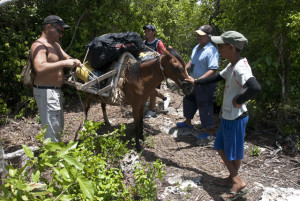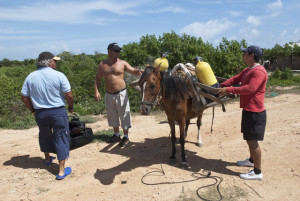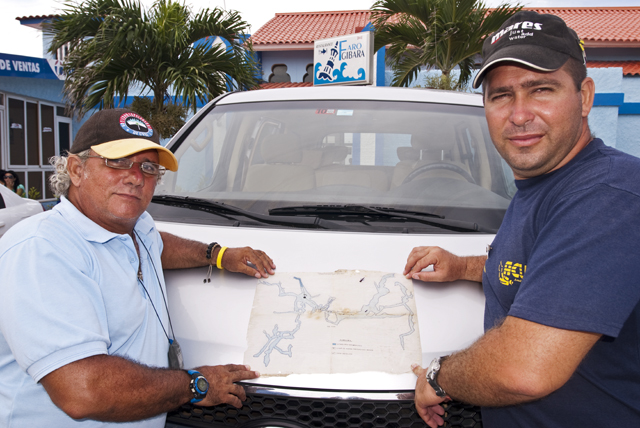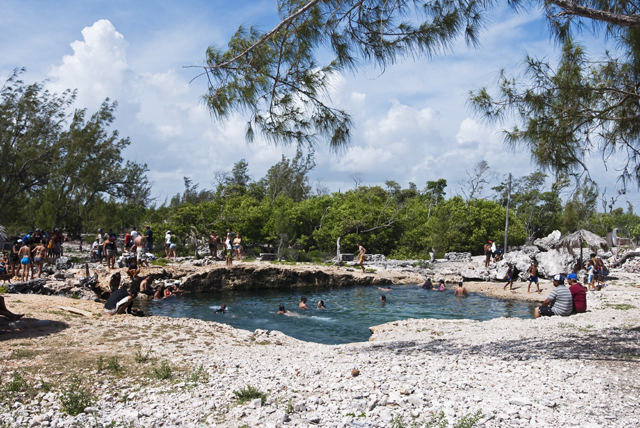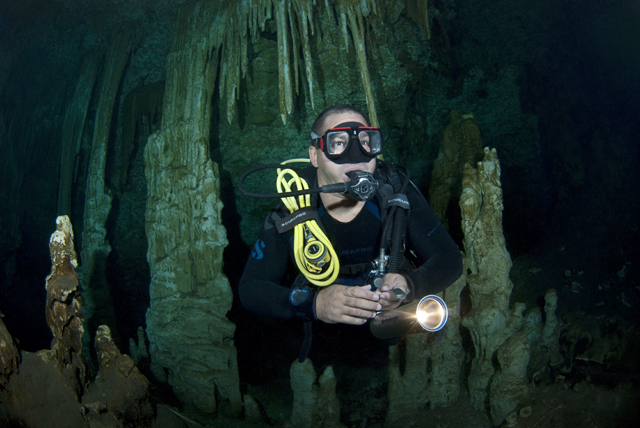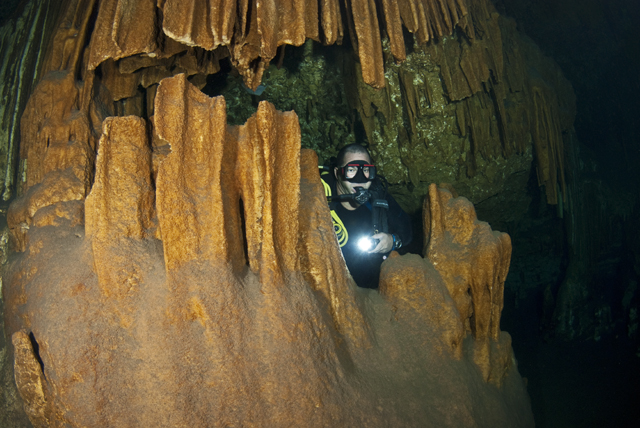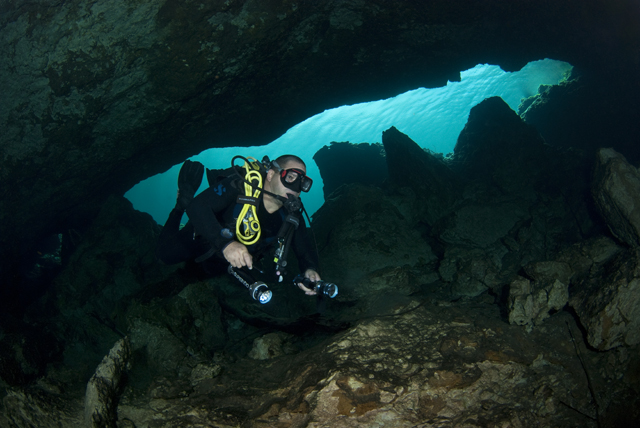News
Rumble in the Jungle: Cave Diving in Cuba
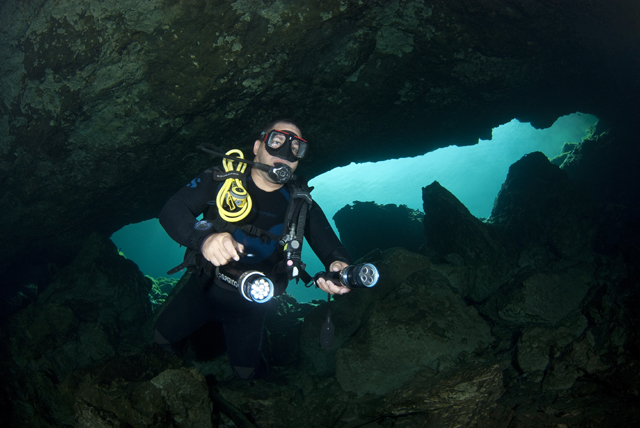
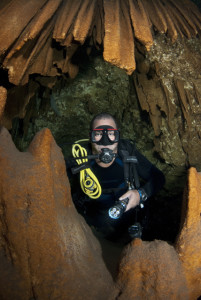 I was busy humming the Indiana Jones theme tune as we made our way through the jungle. This was by no means a ‘normal’ diving day and had turned out to be a real life adventure complete with the full entourage of creepy crawlies. Our tropical surroundings were alive with squawking Birds, Crabs, Geckos, Snakes (not poisonous I might add) and other exotic bugs. I was definitely experiencing raw Cuba at its very best. Jorge Millet Corchete, the Manager of Eagle Ray Dive Centre, had told me about two, virtually un-dived, underwater cave systems located 70km from the popular beach resort at Guardalavaca. After buttering me up with the exciting bits he then hit me with the bad news: the first cave system, known as Ring Hole, was a 1km walk through dense bush in the swelteringly hot sunshine. Worst still, the second system called Blue Tank, which in Jorge’s mind was much better for photographs, clocked in at more than 3km’s from the drop off point. Why are the best sites always the furthest away and hardest to get too? The saying ‘no pain, no gain’ came to mind as I mentally prepared myself for the cardiac inducing hike.
I was busy humming the Indiana Jones theme tune as we made our way through the jungle. This was by no means a ‘normal’ diving day and had turned out to be a real life adventure complete with the full entourage of creepy crawlies. Our tropical surroundings were alive with squawking Birds, Crabs, Geckos, Snakes (not poisonous I might add) and other exotic bugs. I was definitely experiencing raw Cuba at its very best. Jorge Millet Corchete, the Manager of Eagle Ray Dive Centre, had told me about two, virtually un-dived, underwater cave systems located 70km from the popular beach resort at Guardalavaca. After buttering me up with the exciting bits he then hit me with the bad news: the first cave system, known as Ring Hole, was a 1km walk through dense bush in the swelteringly hot sunshine. Worst still, the second system called Blue Tank, which in Jorge’s mind was much better for photographs, clocked in at more than 3km’s from the drop off point. Why are the best sites always the furthest away and hardest to get too? The saying ‘no pain, no gain’ came to mind as I mentally prepared myself for the cardiac inducing hike.
Jorge said at the beginning they used to cover the journey in rented 4 x 4’s but the hire companies got wise when the Jeeps kept coming back completely trashed. Jorge seemed to think that the gentle ‘stroll’ added an extra ‘feel good factor’ to the whole experience. I didn’t have quite as many positive vibes as Jorge but after some gentle persuasion (one or two Mojitos – I’m cheap!) I agreed to take part in the event.
We stopped off at the town of Gibara along the way to pick up some 4-legged help. Jorge’s friend Floro owned the Mule that we were using to carry all our diving equipment. I asked Floro what the Mule was called but he told me that it changed daily depending on how he felt. I decided to call the Mule ‘Pepe’ as it seemed quite appropriate for this neck of the woods.
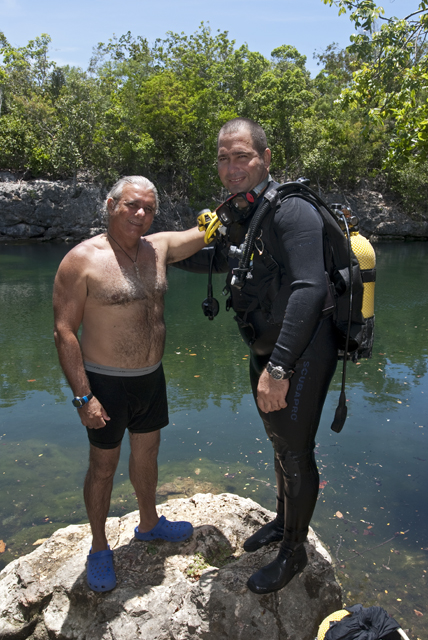 We had also picked up Jose Corella, the local cave diving Guru. Jose, a Geologist by trade, had been diving inside the caves since the late 80’s and had clocked up more than 300 deep penetration dives. He became fascinated by above water caves from an early age. Military friends introduced him to the Blue Tank and the rest was now history. Jose showed me the detailed maps he had made of the cave systems. He had chartered more than 3,000 metres inside the Blue Tank and so far had not reached an ending in any of the 3 independent entrances. Jose had a theory that Ring Hole may well join up to the Blue Tank, it’s just that no one had tried to find out. As well as making maps Jose had laid most of the 3,000 metres of line complete with directional arrows for other divers to follow. As far as Jose knew Czech divers were the first to explore the caves back in 1982. Eagle Ray Dive Centre began offering guided dives to UK tourists in 2004. Jorge said that divers have to be minimum PADI Advanced qualified to explore in the light zone (around the entrances) and he prefers them to do several standard sea dives before venturing inside the caves. This gave Jorge a chance to check the divers out and see how comfortable they were in the water. Jorge said he would only take certified cave divers deeper inside. So far there have been no serious incidents at Ring Hole or the Blue Tank.
We had also picked up Jose Corella, the local cave diving Guru. Jose, a Geologist by trade, had been diving inside the caves since the late 80’s and had clocked up more than 300 deep penetration dives. He became fascinated by above water caves from an early age. Military friends introduced him to the Blue Tank and the rest was now history. Jose showed me the detailed maps he had made of the cave systems. He had chartered more than 3,000 metres inside the Blue Tank and so far had not reached an ending in any of the 3 independent entrances. Jose had a theory that Ring Hole may well join up to the Blue Tank, it’s just that no one had tried to find out. As well as making maps Jose had laid most of the 3,000 metres of line complete with directional arrows for other divers to follow. As far as Jose knew Czech divers were the first to explore the caves back in 1982. Eagle Ray Dive Centre began offering guided dives to UK tourists in 2004. Jorge said that divers have to be minimum PADI Advanced qualified to explore in the light zone (around the entrances) and he prefers them to do several standard sea dives before venturing inside the caves. This gave Jorge a chance to check the divers out and see how comfortable they were in the water. Jorge said he would only take certified cave divers deeper inside. So far there have been no serious incidents at Ring Hole or the Blue Tank.
We drove to a clearing and waited for Pepe the Mule to arrive. Jorge, an ex-Cuban Navy SEAL, had stripped down to his waist and was raring to go. I followed Jorge’s lead by ripping off my t-shirt and slapping on a good helping of factor 30. I had put the Strobes and other camera/dive gear into my rucksack which now weighed in at around 15kg’s. I thought it would be best to carry my housing and camera by hand. In no time at all Pepe had arrived, was packed, had a poo and began trotting down the jungle path. I followed along behind Jorge and Jose (dodging Pepe’s fall out). The track was mainly made up of broken uneven rocks making it very difficult to walk on. My flip-flops weren’t exactly the most appropriate footwear for this kind of terrain. I managed to stub my toes (and swore) a number of times. I asked Jose why they hadn’t made a proper pathway to the Blue Tank and he said that this would only encourage more locals to visit the spot and he preferred to keep them away. He told me there had been a 30 metre long underwater tunnel connecting the town’s popular swimming hole to the open sea. Authorities decided to block up the entrance, with a controlled explosion, after a number of people drowned trying to breath hold swim through the tunnel. Jose didn’t want the caves to suffer a similar fate. Jorge said ‘nearly everyone moans about the walk and they constantly ask ‘are we there yet?’ but when they see inside the caves they are much happier and forget about the return journey’. Jose talked non-stop for the whole 3km’s, which was enough to distract me from the ever growing number of Mosquito blotches appearing all over me (I counted about 30 in total).
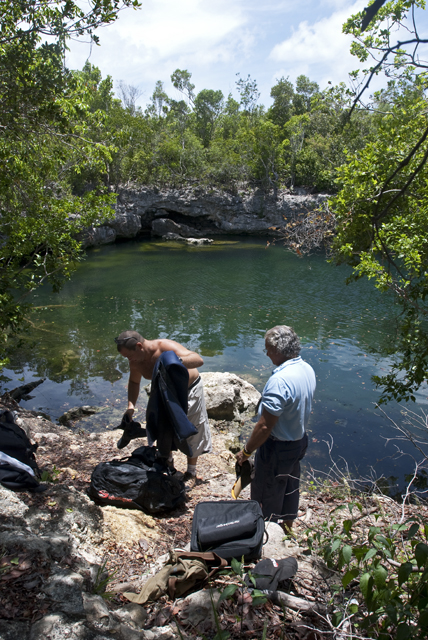 Jose said that the pond measured in at 30 x 15 metres. The seemingly ‘dead pool’ was surrounded by dense bushes and trees apart from one spot where there was a narrow pathway leading down to the water’s edge. Jorge saw a something break the mirror calm surface. A Turtle popped its head up and then quickly disappeared again. This is the first time he had ever seen a Turtle in the pond.
Jose said that the pond measured in at 30 x 15 metres. The seemingly ‘dead pool’ was surrounded by dense bushes and trees apart from one spot where there was a narrow pathway leading down to the water’s edge. Jorge saw a something break the mirror calm surface. A Turtle popped its head up and then quickly disappeared again. This is the first time he had ever seen a Turtle in the pond.
Jorge guided me to the first cave entrance which was big enough for at least six divers to enter side by side. The bottom of the pond was around 6-8 metres deep and covered in a thick luminous green layer of algae, branches and dead leaves. I stopped to take a picture of Jorge entering the cave and felt something feeding on my ankles. I looked down and saw hundreds of Prawns ‘cleaning’ any part of my skin they could find. The pond was far from dead. I had missed out on some really good Macro opportunities.
My equipment wasn’t adequate for a full-on penetration dive but I decided to take a risk and venture in more than 100m’s keeping a firm eye on the guideline and my air gauge needle. The inner chambers were massive with 2 metre long spiky Stalactites hanging from the roof and stubby Stalagmites growing up from the cave floor. When I’m taking photographs I sometimes use a finger touch on a rock just to steady myself. But as I touched the top of a small Stalagmite it broke off. It was only a small piece just a few cm’s long but I was absolutely mortified. It had been such a gentle touch. I had no idea that they were so fragile. I really did learn a valuable lesson and doubled my buoyancy efforts. A diver with bad buoyancy skills inside this cave would be equivalent to a Bull in a China shop – nothing would survive. Afterwards Jorge told me that the orange looking rock formations were much stronger than the white looking ones. I wish he had said something earlier!
The huge chambers (as a rough guide – the size of a Bungalow) were an impressive sight and the further I went in the scenery just got bigger and better. The chambers seem to alternate between all Stalagmites and then all Stalactites. Jorge said that the maximum depth he had ever reached inside the caves was around 18 metres with the average depth being 15 metres. Water temp hovered around 24 degrees. Jorge suddenly made an ‘ugh’ noise from his regulator and as I turned around I caught sight of an Eel about 500cm long swimming away from us. Jorge said there were also 2 species of indigenous blind fish living inside the caves.
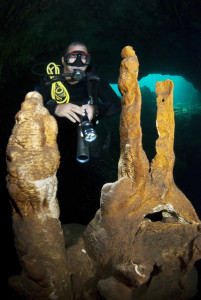
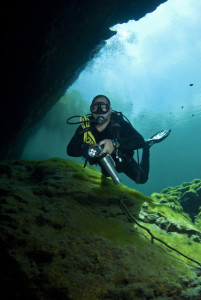 I made the mistake of putting my fins on the cave floor and found it was carpeted by a thick layer of silt. Within seconds my fin had totally sank into the soft quicksand. Even the slightest disturbance reduced the visibility dramatically. I was trying my best to ‘frog’ kick but my longish fins weren’t ideal for this type of environment.
I made the mistake of putting my fins on the cave floor and found it was carpeted by a thick layer of silt. Within seconds my fin had totally sank into the soft quicksand. Even the slightest disturbance reduced the visibility dramatically. I was trying my best to ‘frog’ kick but my longish fins weren’t ideal for this type of environment.
Jorge, or should I say Pepe, had brought along 4 powerful lamps, two of which were brand new, never been used, retailing at $800-00 a-piece. The blue anodised metal cases certainly looked impressive. I strategically placed the lamps on the floor of one of the huge Stalactite chambers and pointed them upwards. They lit up the scenery like a theatre stage. I wanted to try and get some shots of Jorge surrounded by the spectacular scenery. Having no natural light to work with made the whole set up quite challenging which I guess is very similar to a night dive where Macro subjects don’t usually pose a problem, but wide angle is much more difficult to light up. I managed to fire off a few pictures and then one of Jorge’s new LED lamps started flickering on and off. When I looked closer I could see water inside the glass and the level was rising fast. This was not a good advertisement for the lamp manufacturer. Later Jose told me that he used to use normal flashlights sealed inside knotted condoms when he first started and never had any problems! We had a good nose inside another of the cave entrances and I was surprised how different it looked. There were far more orange formations and they were a different size and shape.
Unfortunately there had been no time to properly plan and prepare for a full on exploration of the caves. My jungle dive had purely been a recon mission. I had completed a cavern course in the Brecon Beacons several years ago. We spent all of our time in a river or inside a mine shaft. Water temp was around 6 degrees. At the time I remember thinking what is the point in this? It was freezing cold and there was nothing to see, I know this was a training course, but it didn’t inspire me to progress any further. The Blue Tank was different. There were spectacular rock formations and even fish life to see and to be quite honest it was a nice feeling knowing I was only one of several hundred divers that had ever been inside the cave. As for the walk… well to be honest it wasn’t as bad as I imagined, and it did make me feel that I had ‘worked’ for my dive. We finished off our adventure with a few ice cold Bucanero beers and Lobster dinner at the El-Faro Restaurant. Not a bad ending to a full-on day! Jorge said the dinner is normally included in the package price and there’s no extra charge for Mosquito bites. Jorge has full cave diving equipment available at the dive shop but it’s only enough for the Instructors. Anyone seriously interested in going deep inside the caves should bring along their own gear.
Blogs
Get ready for the Marine Conservation Society’s annual Great British Beach Clean this month

The programme is one of the largest marine citizen science activities of its kind in the UK. Volunteers taking part will not only be clearing our beaches of litter, but help the Marine Conservation Society, the UK’s leading ocean membership charity, to gather vital data to create change for cleaner and healthier seas.
This year’s Great British Beach Clean is being sponsored by Ireland’s leading soup brand, Cully & Sully Soup, whose support is helping to raise awareness of marine litter and protect UK beaches from pollution.
To sign up for a beach clean, or organise your own, simply visit the charity’s website.

Key stats and facts
- At last year’s Great British Beach Clean, 5,416 volunteers conducted 428 beach cleans over 10 days, surveying 64,139 metres of coastline. A total of 129,391 pieces of litter were collected, filling 1,426 bags and weighing 7,476 kg.
- The Marine Conservation Society has recorded an average drop of 80% in carrier bags found on UK beaches since charges were introduced, showing that policies to reduce plastic work.
- Data collected during the Great British Beach Clean contributes toward the charity’s annual State of our Beaches report. Last year’s report recorded a 14% increase in drinks-related litter.
- The report also showed that nine out of 10 beach litter items found on beaches by Marine Conservation Society volunteers last year were made from plastic.
- Sewage plays a large part in the pollution problem. In 2023, over 29,500 sewage-related items, including more than 21,000 wet wipes, were recorded across the UK and Channel Islands, with sewage-related items present on 72% of surveyed beaches.
- Data from the Marine Conservation Society’s Great British Beach Clean contributes to a global database, International Coastal Cleanup.
Key messages:
- Data collected by volunteers during the Great British Beach Clean shows the positive result of policies like carrier bag charges, and how they work to reduce litter on our beaches.
- Plastic still remains the most common form of beach pollution – highlighting the urgent need for further action to tackle the single-use plastic problem such as charges, bans and deposit return schemes.
- The Marine Conservation Society is calling for governments across the UK implement world-class deposit return schemes for drinks containers including glass, plastic, and cans, without any further delay. Currently the proposed scheme is set to start in October 2027, but with Wales being the only country to include glass.
- The charity hopes that the recent bans on single-use plastics, such as cutlery, will lead to a noticeable reduction in the amount of single-use plastic cutlery polluting our beaches, much like the positive impact of the carrier bag charge.
- Sewage-related pollution, such as period products and wet wipes, are still prevalent on our beaches. Governments of the UK must turn the tide on pollution and end untreated sewage damaging our marine environment.
- You can support the charity by helping to clean up the UK’s beaches and collecting valuable data that supports efforts to address sewage pollution effectively.
ON THE DEPOSIT RETURN SCHEME:
Lizzie Price, Beachwatch Manager at the Marine Conservation Society: “It’s fantastic to see real-world evidence of the effectiveness of policies such as carrier bag charges in tackling pollution from single-use plastics. There’s no denying that these measures have helped to reduce litter on our beaches. However, we cannot afford to become complacent.
“Drinks-related litter, such as bottles and cans, were found on 97% of UK beaches surveyed last year. We need wider policies such as charges, bans, or deposits on more single-use items where possible, including the proposed deposit return schemes for plastic bottles, cans, and glass. We must keep moving towards a society that repairs, reuses, and recycles.”
ON SEWAGE POLLUTION:
Rachel Wyatt, the Marine Conservation Society’s Water Quality Policy & Advocacy Manager:
“Our seas cannot sustain the deluge of sewage that is being dumped into our waterways on a weekly basis. Our beach clean volunteers find thousands of sewage-related litter items washed up on the beaches every year, but it’s not just physical pollution that is harmful to us and marine life. Raw sewage contains a cocktail of bacteria, viruses, harmful chemicals, and microplastics which is a disaster for our ocean. Governments of the UK must turn the tide on pollution and end untreated sewage damaging our marine environment, so that we can all enjoy sewage-free seas.”

ON VOLUNTEERING:
Clare Trotman, Beachwatch Officer at the Marine Conservation Society, said: “The work we do at the Marine Conservation Society simply wouldn’t be possible without the dedication of our volunteers, who help gather crucial beach litter data. This information is invaluable in shaping scientific understanding and driving the changes needed to protect our precious marine environment.
“With beach cleans taking place all over the UK and Channel Islands, there are countless opportunities to get involved and support us this year. And if you can’t make it to the beach, you can still contribute by organising a local litter pick and survey in your area.”
Cully Allen from Great British Beach Clean sponsor, Cully & Sully Soup, said: “We are excited to be part of the UK’s biggest beach clean initiative for a third year. As a B Corp, doing good is at the core of what we do. We are always striving to do better internally as a business, but we really enjoy when we get to encourage and join our customers in doing good. We are looking forward to getting stuck into the beach cleans again this year, serving up our soup to the SOUPer volunteers and taking direct action on marine litter.”

The following beach cleans are currently set to take place:
| Date | Region | County | Beach & link |
| 20/09/2024 | Weston-Super-Mare | North Somerset, England | Uphill Beach |
| 20/09/2024 | Wirral | Cheshire, England | West Kirby Beach |
| 21/09/2024 | Weston-Super-Mare | North Somerset, England | Sand Bay Beach |
| 21/09/2024 | Cramond | Edinburgh, Scotland | Cramond Beach |
| 21/09/2024 | Aberdeen | Aberdeenshire, Scotland | Aberdeen City Beach |
| 22/09/2024 | Formby | Merseyside, England | Formby Beach |
| 23/09/2024 | Portsmouth | Hampshire, England | Southsea Beach |
| 25/09/2024 | Littlehampton | West Sussex, England | Littlehampton East Beach |
| 27/09/2024 | Swansea | Glamorgan, Wales | Swansea Beach |
| 27/09/2024 | Portstewart | Londonderry, N. Ireland | Portstewart Beach |
| 27/09/2024 | Cleethorpes | Lincolnshire, England | Cleethorpes Beach |
| 27/09/2024 | Brixham | Devon, England | St Mary’s Beach |
| 28/09/2024 | Rhoscolyn | Isle of Anglesey, Wales | Borth Wen Beach |
| 28/09/2024 | Charmouth | Dorset, England | Charmouth Beach |
| 29/09/2024 | Wallasey | Merseyside, England | New Brighton Beach |
Find more information about the Marine Conservation Society at www.mcsuk.org.
News
Magdelena Bay: Experience the Mexican Sardine Run this November with Indigo Safaris

November 3 to 10, 2024 – aboard the Gallant Lady
October 19 to 26, 2025 – aboard the Nautilus Explorer
The Experience
From October to January, an extraordinary event unfolds in the nutrient-rich, vibrant blue waters off Magdalena Bay, where striped marlin gather to hunt during the second-largest sardine run in the world. This breathtaking underwater spectacle is one you won’t want to miss.
Set sail aboard the Nautilus Gallant Lady as we cruise along the stunning Baja California coastline. Our destination? The tranquil waters and outer islands of Magdalena Bay, where massive schools of sardines congregate. Each fall, an oceanic upwelling merges with warm waters, creating ideal conditions for these sardines in the shallow, cobalt-blue waters. These waters teem with life, featuring bait balls and predators such as seabirds, blue and mako sharks, sea lions, whales, dolphins, wahoo, and the fastest fish in the ocean—the striped marlin. With speeds reaching 50 mph (80 km/h), it’s a thrilling experience to be in the water next to a bait ball, watching marlin zoom past with their dorsal fins fully extended. You might also encounter pelicans, gulls, booby birds, frigate birds, shearwaters, and even the majestic albatross.
Trip Highlights
- Witness one of the world’s largest sardine hunts in Magdalena Bay
- Snorkel alongside striped marlin as they prepare for a feeding frenzy
- Chance to see California sea lions, dolphins, wahoo, and more
- Spot humpback whales and, if lucky, possibly orcas or blue whales
- Scuba dive the SS Independence and a WWI submarine wreck
- View pelicans, gulls, booby birds, frigates, shearwaters, and albatross
Pricing
November 3 to 10, 2024 on Gallant Lady
- Superior Suites: $3,670 USD per person (tax included) – 0 spots left
- Premium Suite: $4,195 USD per person (tax included) – 1 spot left
- $35 USD port fee (paid onboard)
October 19 to 26, 2025 on Nautilus Explorer
- 1 Triple room berth: $3,355 USD – 1 spot left
- 2 Single Suites: $4,455 USD – 2 spots left
- 2 Superior Suites: $3,775 USD per person (tax included) – 4 spots left
- 1 Standard Suite: $3,564 USD per person (tax included) – 4 spots left
- $35 USD port fee (paid onboard)
Inclusions
- Accommodation
- All meals: continental breakfast, breakfast, lunch, dinner, and dessert
- Non-alcoholic beverages and snacks
- Daily room service
- Towels and onboard facilities (including hot tub and lounge)
- Lots of fun!
Exclusions
- Airport transfer
- Bar and gift shop purchases
- Crew gratuities
- Internet access
- $35 USD port fee
Photography Coaching
Underwater photography coaching will be provided by Christopher Bartlett, the founder of Indigo Safaris and an experienced underwater photographer. Christopher’s work has been featured globally, and he has published over 100 articles on diving and marine conservation. His photography has appeared on numerous dive magazine covers. During the trip, Christopher will offer photography guidance, from basic to advanced lighting techniques for macro and wide-angle shots. He’ll help you set up your gear and process your images in Lightroom. Christopher has been leading Cetacean trips since 2015 and has extensive experience with species like sperm whales, humpbacks, sharks, sea lions, dolphins, and bait balls.
The Journey
Embark on the luxurious 116 ft, six-cabin expedition yacht, Nautilus Gallant Lady, and follow this remarkable migration across the Sea of Cortez. Whether you’re a snorkeler, swimmer, or diver, this trip caters to all experience levels. We’ll ensure you get ample time in the water with schools of mobula rays. Some encounters may last just minutes, while others could extend for over an hour—and sometimes, the rays may even welcome you into the middle of their formation. A bonus experience? Special night encounters with rays as they gather around our dive lights in shallow, protected bays.
Who is this trip for?
This adventure is perfect for both divers and snorkelers. While there are a couple of dive days, non-divers can enjoy the action through snorkeling. Most of the bait ball excitement is best experienced while snorkeling.
Day 1
Arrive at SeeCreatures Cabo by 4:30 pm. After boarding, we’ll set sail along the stunning Baja California coastline, heading toward the sheltered waters and outer islands of Magdalena Bay, home to the famous sardine run.
Day 2
Kick off the adventure with three dives at the southern end of Margarita Island, where you’ll explore sites that include playful sea lions and the remains of a steamship that sank in the early 1900s.
Days 3 – 6
It’s time to hunt for bait balls and jump into the water with striped marlin! This eco-tourism experience is a collaboration with local pangas and expert captains. Captain G and his family and friends are masters at locating bait balls, giving you the best chance for marlin encounters. Spend as much or as little time on the water as you like—the more time you invest, the more striped marlin sightings you’ll enjoy. Scuba diving is also a core part of the itinerary.
Magdalena Bay teems with life at this time of year. Alongside marlin, you could see whales, dolphins, turtles, sharks, and sea lions. Don’t miss the chance to explore the nearby mangroves and stunning sand dunes. For added adventure, kayaks and stand-up paddleboards (SUPs) will be available for your use.
Day 7
On the final day at Magdalena Bay, we’ll wrap up with three more dives, including a dive at the wreck of a WWI submarine and another sea lion encounter.
Day 8
Disembark at SeeCreatures Cabo after enjoying a final breakfast at 8:30 am.
The Vessel
Accommodating 12 passengers in six spacious suites, the Gallant Lady offers a luxurious and comfortable experience. The cabins are split between the lower and main decks, featuring five Superior Suites and one Premium Suite. Each suite is equipped with individually controlled air conditioning, a California king or two double beds, ample storage, and private en-suite bathrooms.
Superior Suites – Inde, Dofleini, Rosario, Nautilus & Swell
Two Superior Suites are located on the main deck, while the remaining three are on the lower deck. Four of these suites can be configured with either a California king bed or two double beds. Each suite includes a private en-suite bathroom with a shower and individually controlled A/C.
Premium Suite – Emerald
The spacious Premium Suite, located on the lower deck, offers flexibility with either a California king bed or two doubles. It also features a private en-suite bathroom with a full-sized bathtub.
Social Spaces
The Gallant Lady is designed with several comfortable social areas to help you unwind. The sky lounge on the top deck, complete with a hot tub, is the perfect spot to enjoy a cocktail after a day of adventure. Relax between dives on the sundeck, or take in the wrap-around views from the main salon and dining room, which also boasts a fully stocked bar.
The onboard chef prepares a delicious fusion of Mexican and West Coast North American cuisine, and all dietary requirements can be accommodated with advance notice.
For more information or to book, contact Indigo Safaris:
Email: safariexperts@indigosafaris.com
UK: +44 771 334 27 29
USA: +1 718 312 8777
France: +33 668 74 97 05
Skype: christopherbartlett
-

 Blogs1 month ago
Blogs1 month agoGozo: An Underwater Treasure Trove in the Heart of the Mediterranean
-

 News3 months ago
News3 months agoMurex Bangka Announce New Oceanfront Cottages & Beachfront Dining
-

 Gear Reviews2 months ago
Gear Reviews2 months agoGear Review: Scubapro Luna 2 AI Dive Computer
-

 Marine Life & Conservation3 months ago
Marine Life & Conservation3 months agoIceland issue millionaire whale hunter a licence to murder 128 vulnerable fin whales
-

 Blogs2 months ago
Blogs2 months agoMamma Mia! Diving Skopelos (Part 1)
-

 News2 months ago
News2 months agoDived Up release NEW Second Edition of Diving Gozo & Comino by Richard Salter
-

 Marine Life & Conservation3 months ago
Marine Life & Conservation3 months agoSHARK MONTH ARRIVES AT ROYAL WILLIAM YARD, PLYMOUTH
-

 Blogs2 months ago
Blogs2 months agoAlonissos: The complete diving destination (Part 1)


